Can your gadgets really live off solar power alone?

Mobile technology is advancing at a startling rate, with the average smartphone now boasting the kind of computational power we'd normally associate with laptops or even desktop PCs.
However, one aspect of these devices which has remained depressingly static is battery life.
Back in the 'dumbphone' days it wasn't unrealistic to expect your trusty Nokia 8210 or Sony Ericsson K700i blower to last a week on a single charge, but modern handsets like the iPhone 7 and Galaxy S7 are lucky to get through a single day before they're gasping for a top-up.
While advances such as quick-charging and larger capacity power cells are a step in the right direction, it's clear that a big breakthrough in the world of batteries is yet to come. The problem has led to a rise in alternative charging options, such as external battery packs and solar chargers.
The solar solution?
While I've personally dabbled with portable battery packs myself – largely in response to Pokemon GO's insatiable appetite for juice – solar power wasn't something I'd seriously considered before laying eyes on the £40 dodocool 1000mAh portable solar charger.
Harnessing the free energy of the sun is big business right now – as the many households with solar panels on their roofs will attest to. Even big tech players like Tesla are getting in on the action.

Given my personal need to walk around constantly with apps such as the aforementioned Pokemon GO gobbling up my precious mobile power, I decided to take the plunge and see if I could realistically survive an entire week just using the light of the sun to power my iPhone 7 – all in the name of journalism, of course.
Sign up for breaking news, reviews, opinion, top tech deals, and more.
The kit
The start of the week was largely spent figuring out how the dodocool charger actually works.
It's clad in tough fabric and houses two panels. An adjustable kickstand on the back allows you to place it in the optimum position, while a handy little orange LED indicates when it's sucking up those lovely sun-rays and turning them into food for your mobile devices.
Unlike some other solar panels on the market which only provide direct power to your device, dodocool's offering conserves energy in its roomy 10000mAh Li-Polymer battery, which can supply 2.1A of charging power via its two USB ports. You get a MicroUSB cable in the box, but naturally you can use your Lightning or USB Type-C cable, should your device require it.

The solar panels fold in on themselves for easy storage, and the battery and USB ports are hidden away in a zip-up pocket on the back, which also has room for your phone so you can stow it away safely during charging. Because there are two USB ports you can top-up more than one device at a time, which is handy if you're with someone who also needs a bit of juice.
When your phone is connected to the unit it will charge its battery as soon as sunlight hits the panels as the unit prioritises connected devices over topping up its own internal battery, but if you're indoors and simply want to use the conserved energy you press a button on the unit which places it in charging mode, even if the panels are folded down. Four blue LEDs denote the amount of charge left in the 10000mAh battery.
Catch the sun
Day one was unsurprisingly spent charging up the panel itself, a process which takes quite a while as the panels are only capable of turning around a quarter of sunlight into usable power.
Most of the day was therefore spent repositioning the unit in various windows to compensate for the movement of the sun; like all solar panels, dodocool's option works best when in direct sunlight. Clouds reduce its functionality, although I noticed that the charging LED remained lit even when the sun was struggling to peep through the grim November clouds.
Even on the most overcast and gloomy day of my test, the charger continued to pick up some energy, which alleviated one of my biggest fears: that the traditionally downcast British weather would make such a device about as useful as a one legged-man at an arse-kicking contest. I had no issue filling up the charger 10000mAh battery when I was in the house – the only headache was constantly moving it from window to window to ensure it made the most of the available sunlight.
Having proved beyond all doubt that such a panel had its uses indoors, I decided to risk my self-esteem by venturing outside on day three.
The Dodocool panel has four metal eyelets in each corner which allow it to be worn on your back as you walk around, like a backpack. This offers some tangible benefits over having your phone constantly connected to an external power bank; it's less weight in your pocket (with the tradeoff being that you have a massive solar panel strapped to your person) and it provides a constant charge, so if you're going on a particularly long trek you don't need to worry about your power bank draining to nothing and being without any juice for your beloved gadgets.
Blue-sky charging with the god-rays
With its 10000mAh capacity I was able to fully charge my iPhone 7 three times over before the dodocool needed topping up, which gave me roughly three days of juice with each sunlight suck-up (obviously phones with larger capacity batteries will get less charges). Android users accustomed to the luxury of fast-charging will want to note that the panel can only output a maximum of 2.1A, which means you should expect slower charging speeds than you're used to.
Even when taking into account days where Mr. Blue Sky refused to show his face, as long as I had the panel open and near a window, it continued to slowly drink those god-rays.

A short walk every day or two also helped replenish the well, and once I'd fallen into a routine, I didn't even miss the wall socket I had forbade myself to use during the duration of the test. In mobile terms at least, I had successfully taken myself off-grid. The only time that I encountered a genuine issue was when it rained, which prevented me from talking a top-up stroll.
When you consider that the dodocool solar charger costs £40 (about $50, AU$67), it's tempting to consider if you should buy several of them and secrete them around your home / post-apocalyptic fortress / impenetrable bunker and therefore avoid paying for the electricity you'd normally burn through in order to charge your family's phones each and every day.
Of course, the practicalities of carrying around a solar panel with you everywhere you go mean it's not going to be an option for everyone, and an entire week of terrible weather could well throw your solar-charging plans into disarray.
But when the zombie apocalypse comes and the energy supply inevitably gets cut off, you might be thankful of having such a gadget in your armoury.
You'd also be without a phone signal while humanity crumbles around you of course. But that's a problem to solve another day...